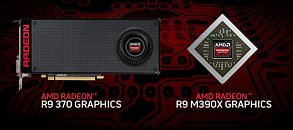Tuesday, June 9th 2015

AMD Radeon R9 370 Reference Design Board Pictured
Alienware leaked the first images of AMD's upcoming Radeon R9 370 graphics card and R9 390M GPU. The card's design looks a lot like the liquid-cooled Fiji-XT "Radeon Fury" board that's being pictured around these days. If the picture Alienware is from AMD, then it's safe to assume that both the R9 370, and the R9 390M will be based on the 28 nm Curaçao silicon. The only major change here, will be the standard memory amount, which has been bumped to 4 GB from 2 GB, thanks to the 4 Gbit GDDR5 chips that are becoming commonplace. AMD is expected to launch these cards a little later this month. The Curaçao silicon features 1,280 GCN stream processors, 80 TMUs, 32 ROPs, and a 256-bit wide GDDR5 memory interface.

29 Comments on AMD Radeon R9 370 Reference Design Board Pictured
I guess I am not happy with the rebranding because its basically something we already had years ago and they try to promote it as something entirely new. I am sure it has a few new features/aspects, but if the fundamental design is 3 years old, in the gaming world, it might as well be junk.
O whats that you want DX12_1 support sorry your "brand new gpu" only supports DX12_0.5
Isn't that the beauty of rebrands you don't have to "clear" the existing flow of chips in the channel. They just say at this point forward; revise clocks/bios and slap them with a new look and box's, while AMD doesn't sweat the distribution side of it. I mean do we think AMD AIB's have had 8mo's of inventory built up of old 200 Series moniker that they had to wait this long for that sell off? Some 280X and 290's friends have gotten back in mid-May showed BOD's of early April. Why would AMD hold off if straight-up re-brands, do they really think releasing them as complete series makes it more applicable? I suppose some marketing type believes it’s better to have a defining cut-off, that then "hooks" it to the Halo part, but at this point I'd say working that momentum vanished. It might have been a good move when Hawaii came about, but to try it again on the 28nm process is seriously pushing it. Even if Fiji is a win, if they couldn't modernize (GCN 1.2) at least Hawaii, and whatever is below Tonga, it warrants being victims of their own short sidedness.
Or, are they betting that everyone will be "enthralled" with the whole Dx12 (as MS is showing at E3), and now GCN with Asynchronous Compute Engines boost performance that somehow it all makes it acceptable? Against the Maxwell (2) 900 Series which has that similar capabilities that’s less to seen as any big metamorphosis.
Just speculating of course, I'm not 100% on it myself.